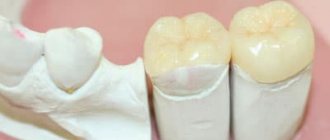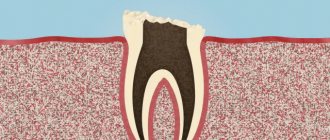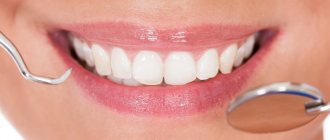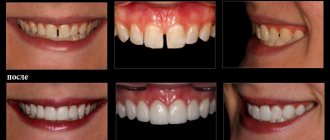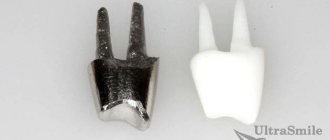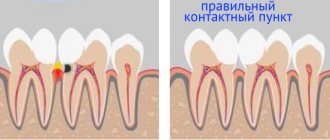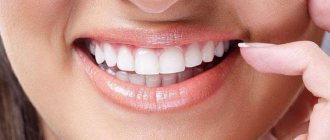Every patient wants to have healthy and beautiful teeth and tries to properly care for them in order to preserve them. But sooner or later, at a dentist’s appointment, problems are discovered that require a choice to be resolved. What should you do if you go to the doctor to treat caries and get a filling, but he strongly recommends a crown? To answer this question, you need to understand the causes of tooth decay, the features of fillings and crowns, the advantages and disadvantages of each type of restoration.
Causes of tooth decay
Tooth decay is a pathological multifactorial process, which is usually caused by a combination of external and internal negative factors. Tissue demineralization occurs, as a result of which enamel and dentin are destroyed and a cavity is formed. If the process is not stopped, the destruction progresses and the size of the defect quickly increases. Why is this happening? Let's list the main factors.
- The presence of cariogenic microflora in the mouth of every person.
- Deficiency of microelements and vitamins in the body: fluorine, molybdenum, phosphorus, strontium, calcium, vitamins B and D; and, as a result, weakness of the hard tissues of the tooth.
- Decrease in pH in the oral cavity due to frequent consumption of carbohydrates and sweet carbonated drinks.
- Pathogenic dental plaque formed by carbohydrate residues.
Restoration methods are divided into 2 categories:
- direct method - performed in the patient’s mouth using photopolymer or light-curing fillings;
- indirect method - making crowns in a dental laboratory.
A case from our practice
The patient, on recommendation, came to our dentistry for treatment. Previously, in another clinic, one of the chewing teeth was restored with the help of an impressive filling. The “BEFORE” picture shows the filling during the first visit to NOVODENTA+, 1 year after it was placed.
The strong chewing load and the scale of the filling itself led to a loss of tooth aesthetics and partially affected the bite.
And here we are talking about another advantage of crowns - they are made from impressions in the clinic’s own laboratory, and the filling is placed directly in the mouth. The filling cannot completely reproduce the anatomy of the tooth and therefore the patient may experience discomfort, additional stress on the TMJ and, as a result, pain.
What is a filling
A filling is a restoration that is created by filling a cavity or replacing a defect (building up) with filling material. Its main difference from a crown is that it is created directly in the patient’s mouth, and not in a dental laboratory.
A filling is a more familiar method of dental treatment for many, which is considered traditional, proven and reliable. But in fact this is a rather controversial statement. Firstly, a filling can only replace a small defect. Secondly, it is short-lived and cannot guarantee protection from further destruction.
How long can a filling last, and why is it short-lived? Let's figure it out. The best material for a filling or direct restoration is a light-curing composite. Immediately after installation, it really fits perfectly to the walls and looks great. But the most vulnerable place of any restoration is the “filling-tooth” boundary. The fact is that it is not always possible to polish this area perfectly, especially when it comes to the interdental space, and caries very often occurs in this area. Soft carbohydrate food debris can accumulate in this area and after some time, cariogenic microbes accumulate here, consuming carbon from the filling material. After some time, the edge seal in the composite material is inevitably broken. As a result, after 2-3 years, secondary caries is discovered under any filling. To eliminate it, it is necessary to remove the old filling, destroyed tooth tissue (increasing the size of the defect), and put in a new filling. A few years later everything repeats itself. And over time, the remaining walls of the tooth become thinner. The larger the volume of filling material, the more vulnerable the tooth is to mechanical stress; for example, when chewing a bread crust or cracker, a tooth may unexpectedly crack.
The use of pin and stump inlays when restoring “dead” teeth
At the beginning of the article, we said that removing the nerve (pulp) deprives the tooth tissue of recharge. In addition to deteriorating the adhesion of dental materials, removing the nerve makes the tooth tissue dry and brittle, and the expansion of the canals during their treatment further weakens the tooth walls.
To make the roots of the tooth stronger, before restoring the tooth, reinforcement of the roots is performed with fonts.
If the supragingival part of a tooth is completely destroyed, then pin-and-stump inlays manufactured in a dental laboratory are used to create a tooth stump, on which a crown is then installed.
Now let’s look at what options there are for restoring “living” teeth.
Filling or crown
To make a choice between a filling and a crown, you need to consider several factors:
- cavity size, degree of hard tissue weakening
- cavity shape
- forecast of restoration durability (filling + tooth construction)
It must be remembered that secondary caries develops under the filling; with a large volume of restoration, there is a risk of fracture of weakened hard tissues. Therefore, the only advantage of a filling over a crown is its low price and speed of production. But if you take into account that in a few years you will have to change the filling, it becomes clear that in the end such a restoration will only cost more.
Advantages of extension with filling material
The tooth is built up with photopolymer material if caries has “eaten” less than 1/3 of the tissue. A small extended piece looks aesthetically pleasing and does not catch the eye.
Filling a large defect is also acceptable, but after 3-4 years the filling will have to be changed because it does not strengthen the crown of the tooth. If the cavity is large and a filling is placed in the tooth, it may crack and have to be pulled out. Therefore, a crown is a winning option in 4 out of 5 cases.
Benefits of restoring a tooth with a crown
Dental restoration with crowns has many advantages over fillings.
Protecting remaining tooth tissue from recurrent caries
If a significant part of the tooth is destroyed, the dentist will recommend making a stump inlay and covering the tooth with a crown. This method allows you to save the tooth and protect it from secondary caries. Food does not get under the crown and inlay, and the marginal seal inside is not disturbed. Therefore, the tooth is not destroyed.
A crown is the most reliable way to preserve your “native tooth” from chips and breakages
Weakened hard tooth tissues with thin walls become fragile. In this condition, even a small mechanical impact is enough to cause a microcrack to form and a piece of the tooth to break off (for example, when biting a nut). The crown reliably protects against chips and breaks.
The indirect restoration method improves the quality of restoration
The advantages of the direct method, i.e. fillings – speed and low price. However, the main goal of aesthetic restoration and restoration - preventing the destruction of deep layers, restoring the natural shape of the tooth and maintaining the bite - in this case it is not always possible to achieve, the doctor’s view of the oral cavity is quite limited. In addition, crowns can now be made in 2-3 hours (using Cerec technology).
When making a crown, it is possible to model the anatomically correct shape of the restoration, getting as close as possible to the individual characteristics of the patient’s dental system. When filling, the dentist does not have this option. Also, ceramic microprostheses are more durable, practically do not shrink, are firmly fixed on the crown of the tooth and strengthen the walls, do not wear out, and do not change color. Thanks to the smooth surface of the ceramic, plaque with pathogenic bacteria does not form on it. Crowns provide precise marginal fit, and some have an additional antibacterial effect.
When is a crown needed?
Prosthetics with a crown is suitable for the following cases:
- untreated caries, due to which most of the tooth has collapsed;
- injuries: chipped pieces of enamel, deep cracks;
- darkening or yellowing of the enamel that spoils the smile.
The dentist offers the patient a choice between a crown and a filling only if both methods are suitable. If the doctor sees that filling a damaged tooth is pointless, he immediately suggests installing a crown.
When half of a tooth is destroyed, dentists recommend installing a veneer. If more than half has fallen apart, it is usually recommended to install a crown.
Before fixing the crown, the doctor drills out the tissue destroyed by caries so that the microbes no longer “eat” the tissue.
Installation of a tooth crown. Types of crowns and fixation methods
Dental crowns help restore the chewing function of the tooth and ensure full load. The method has a large number of indications for use:
- A strong tooth root, but a significant absence of the crown part. A pin is installed in the root, and an individual crown is fixed onto it.
- Strong enamel pigmentation that cannot be bleached. The indication may apply to several teeth at the same time.
- The presence of progressive non-carious dentin diseases.
- Abrasion of tooth enamel; destruction of enamel under the influence of exogenous or endogenous factors.
Dental crown
An alternative method for restoring a damaged tooth is a structure that is placed on a previously ground down tooth.
Its advantages are considered:
- reliability of fixation and protection of the preserved tooth;
- reliable protection of enamel from external bacteria;
- the crown completely copies the shape of a natural tooth without nicks or protrusions, which allows you to preserve the chewing function.
Among the disadvantages it is worth noting:
- the structure of the crown is more rigid and different from a natural tooth, which the patient feels;
- It is possible that the gums may be displaced under the influence of a foreign object – a crown.
Therefore, the feeling of discomfort must be eliminated with the help of additional grinding.
If this measure is not effective enough to restore the tooth, it is possible to install a crown with a pin. This design is considered the most reliable and durable. The pin strengthens the remains of the tooth, and the crown protects against the penetration of bacteria.
Differences
Typically, crowns are much stronger than fillings. The only exceptions are structures made of plastic.
If the filling material falls out, the tooth will require repeated treatment, which cannot be said in the case of an installed crown, which can be reinstalled at any time in the absence of external damage.
Why can our articles be trusted?
We make health information clear, accessible and relevant.
- All articles are checked by practicing doctors.
- We take scientific literature and the latest research as a basis.
- We publish detailed articles that answer all questions.
Fixing crowns takes much longer than the filling process.
Crowns allow you to ideally restore the lost shape of a tooth, while using a filling it is not always possible to achieve this result.
Restoration of front teeth with veneers
Installing veneers is the best option for restoring front teeth.
A veneer is a thin ceramic plate made from an individual impression in a dental laboratory. Its installation requires minor grinding of the tooth and covers the front surface and cutting edge of the tooth. Veneer - ideally conveys the “pattern” of the tooth surface and matches the color of natural teeth, is not stained by food and lasts more than 10 years.
A veneer can be broken under heavy chewing load, so teeth covered with veneers require a measured load and this type of restoration is not suitable for lateral (chewing) teeth.
If the front tooth has significant damage and the nerve has probably already been removed, the tooth should be restored with a crown.
Preparatory actions
Before installing a crown, the doctor must diagnose and sanitize the oral cavity. If there is cariogenic damage on the tooth for restoration, then the doctor carries out treatment.
Teeth crowns are simply placed on the base
The next preparatory stage is turning the tooth or installing a pin. If the coronal part is completely destroyed, but the root is strong, a stump tab is installed. The stump tab strengthens the canals and allows you to securely fasten the crown.
Filling teeth with inlays
Sealing on the pin is performed according to the following scheme:
- Initially, the specialist diagnoses the damaged tooth using various methods. The most informative is dental radiography.
- Radiography provides comprehensive data on: the depth and shape of the canal, the location of the roots. This allows you to select the pin of the desired shape and thickness.
- Dental restoration makes no sense without a sanitation procedure. An initial examination and identification of foci of infection and carious lesions will help avoid premature destruction of the restored tooth. The doctor treats all cariogenic areas and stops foci of inflammation.
- Procedures for preparing root canals for implant installation. The specialist removes the pulp (if required), expands the canals and performs mechanical cleaning. After cleaning with the instrument, it is necessary to rinse the canals with an antiseptic solution.
- Installation of the pin with the selected fastener. A custom or factory-made pin is placed in the root canal, and the remains are removed using a specialized instrument. The canal cavity is filled with dental cement.
- After installing the pin, the specialist begins restoration of the coronal part of the tooth.
- The doctor applies the photopolymer composite layer by layer and polymerizes it with an ultraviolet lamp. This is how the size of the tooth is gradually formed.
